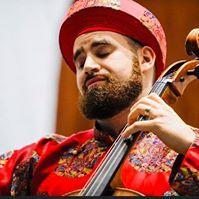Search the Community
Showing results for tags 'chords'.
-
According to this article, 4 part chorale-like voice leading (part writing), despite being taught in music conservatories, is not used in orchestral music. I understand the basic concepts of voice leading, voice independence, which note to double, and resolving in the "right" direction, but I haven't worried to much about learning strict textbook voice leading. (I admit these concepts can be hard to prioritize and I think that might be where I got the idea of adding another voice or two) I know it's a lot, but here are the things I want to clear up for myself: 1. When people write in more than four voices, do they use standard 4 part voice leading and add in additional parts to fill in space, or do they voice lead all of the parts? I imagine both methods are used, but what do I know? 2. Is it easier to voice lead in, say 5 parts, rather than in 4? I understand that the more voices you add, the more responsibility you have to lead (resolve?) all of them, but I feel like a lot of specific rules for specific situations come from the limitations of 4 parts. For example I feel like it might be easier to balance doubling the correct note and writing independent lines, in 5 voices. 3. How is voice leading used in modern composition? I would probably just voice lead the chords and write the melody and countermelody together separate from the chords, not considering them in voice leading (of course except for the difference between perfect authentic cadences and imperfect authentic cadences). 4. How worried are modern composers (I'm sure there's a difference between media composers and "academic" concert stage composers) about line independence and not using parallel fifths octaves and unisons? I know I would never (never say never) try to voice lead in say, eight voices, because it would be impossible to avoid forbidden parallels unless you have a ton of upper chord extensions, like jazz. 5. Do people (if no one does it, I might try it) ever use a different amounts of voices in different sections of a single piece (i. e. five voices in the A section and four in the B section)? If I were to do this, I would redistribute the parts to the instruments, so that doesn't equate to parallel unisons, but this "redistribution" would happen anyway since different sections normally have a different set of instruments. This is just an idea I got, but I'm sure it's not original. 6. Are there any existing systems to voice lead in more than four parts, or is it just the same basic principles (or is only four part voice leading taught, leaving the rest to the composer to figure out)? I know this is a longer post, and I can probably figure some of it out myself, but I would be thrilled if someone of more experience were to offer some insight. P.S. Just to clarify, I know that orchestral music uses part doublings on top of the original part writing; I'm not asking about that.
-
Hey everyone, this is a project I did for my Theory: Intro to Harmony class. We started with just a chord progression, then added texture and a melody. I'd love to hear any feedback, and if anyone thinks of a title, please let me know
- 12 replies
-
- 1
-

-
- jazz arranging
- clarinet
-
(and 2 more)
Tagged with:
-
Not sure what game soundtrack this would fit, but it sounds like it could maybe be music for a loading screen on Animal Crossing or something.
-
This piece is only made using chords. This is just an experiment. feedback expected.BTW Inspired from chopins e minor prelude.(op 28 no 4) https://flat.io/score/5ecfa73218c179027f492cdd-warning-cursed-audio
-
Instructor: @Monarcheon Students: max. 10 Expectations: Composers will learn about music from the contemporary/modern period, analyze it deeply, and will write music in this style. This should span over about a month and composition assignments will be used. Week 1: Bartok - form Week 2: Webern - interval set/vectors Week 3: Messiaen - rhythms/time Week 4: Cage - intro to musical philosophy AKA "real theory" Special Notes: This is our first test long-form masterclass... structured to be more like an actual class. It's a test because I don't know how many people will be interested/care. Let me know if you're interested in the comments.
-
Hi everyone. This is a famous chord progression used in the chorus in pop songs, in the key of C major: F - G - Em - Am - Dm - G - C :|| However, there is a variation of this chord progression. After the repeat, the bass goes as: F# - F - E - Eb - D - G - C Can anyone figure out what are these chords? I'm assuming that they are: F#dim or F#m7-5 - Fm7 - C/E - Ebdim - Dm - G - C Here is an example of the chord progression: Thank you very much!
-
Can you please recommend some songs you identify as fantasy songs personally so I can study the chords and see why, or if you know a common chord progression in fantasy music can you post/comment it? thanks! P.S. - For anyone wondering where the rest of the content here went, I've been doing a lot of studying and putting this stuff together on my own. I'm going to formally type it up somewhere and share the link when it's more or less finalized so I can get critique. 👍 P.P.S. - If you've got some mysterious magical sounding fantasy progressions I'm open to reading what you have. Until I figure it out on my own, hahaha. EDIT/UPDATE: So here's the finished product! http://tiny.cc/gfcbykgl I'll make a post down below where I say a little about it.
-
I need help,I'm really confuse. I heard that C melodic minor scale is half major and half minor, or better it's neither major nor minor. and harmonically it shift back and forward between the major and minor. if it's true, can some one explain to me how to use it....Thank you
-
Hello There, I'm new here : ) I'm looking for a really sad chord progression, can someone help me?
-
Hey, I'm finding quite problematic the handle of chord diagrams when they have parentheses, I'm not sure how did I did it but I could managed sibelius understand the text and automatically create the parentheses and make the additional numbers appear one on top of the other. For the 2nd chord you see in picture, I just write the 1st chord and when I click outside text object it automatically turns into 2nd, BUT I can't write any chord, it seems to recognize only some chords, for instance I try to turn the Eb7 into Ebm7 and it doesn't work, when I click outside it fails to create parentheses and it remains like text and becomes red. How can I handle these type of chord diagrams, or create a new style ? anyone uses parentheses with one number on top of other ? Thanks.
-
So I'm new here, and relatively new to harmonic analysis. I was in the process of studying some old hymns, and ran across a chord I simply can't figure out. It has me stumped. The one that has me stumped is the first beat of the last measure in this selection (which I've uploaded as a pdf). The hymn is obviously in the key of Bb major,and all the other chords are easily identifiable, but what roman numeral should be given to a chord of Eb Bb G and C? Is the C just a non-chord tone? Any ideas? I feel kind of silly not knowing, since the answer is probably a simple one, but I guess the only way to learn is to ask. Opennowthygates.pdf
- 7 replies
-
- harmony
- roman numeral analysis
-
(and 2 more)
Tagged with:
-
Hey everyone I have written a nice sounding string piece and some parts have 6-8 notes with big 7/9th chords and a few of the notes in multiple octives. I wrote it using a string ensemble patch so I didn't have to worry about what instruents played what, but now I want to redo it writing it properly for the seperate stringed instruments but I'm struggling to spread the big chords out. I like the chords the way they are so I don't want to have to take some notes out. How do you spread huge chords across the strings? I'm struggling to decide which strings should play multiple notes. At the moment I'm doing it from a sound direction perspective, so for example if I want it to sound thicker to my left I'll assign more notes to the violins. There must be a better way about deciding which instruments should play mutiple notes? I'm tempted to just scratch scoring for sepeate strings and stick to full string ensemble patches, seeing as it's easy to play huge chords. But I am trying to learn orchestration and would prefer to be able to score for the strings seperatly. Thanks for your time
-
Reading about harmonizing a melody, I have come across the idea that we don't need to change the chords a lot. One author has even said that a chord may not change for several bars. Another has advocated changing the chords during strong beats. I would like to know how we can stay in the same chord if the notes in the melody are always changing and a chord gives us access to only 3-4 of those notes most of the time? Are we supposed to limit ourselves to these 3-4 notes in the composition of additional parts that accompany the melody? And what about notes in the melody that are out of these 3-4 notes? Are they acceptable?
- 7 replies
-
- chords
- harmonization
-
(and 1 more)
Tagged with:
-
Hey everyone :) So I have a nice melody and I am trying to come up with some chords/rythm that work with it. But everywhere I read on harmonizing a melody just says the same thing; simply change to a chord so the melody note lands on either the 1st, 3rd or 5th of the chord. However just doing this all the time sounds rather bland I would like to start experimenting with other chords, but i don't really know where to start. I thought it would be a good idea to just think of the melody notes that don't land on a tone in a triad as extensions. So if the melody lands on a D, I can play a C major chord and think of that as a CMaj 9 (without the 7th) But of couse there are many chord extensions and I find myself taking forever to choose a chord. When I want a chord change I will go through all the chords on a piano so that the melody note will either be the 1st, 3rd, 5th, 7th, 9th, 11th or 13th of the chord, and just test them out. I have absolutley no idea how I would make the decision of which chord to use if I was away from a piano. So yeah, how do you guys decide which chord to use (if it's one where the melody note isn't the 1st, 3rd or 5th)? Thanks for your time :)
- 5 replies
-
- harmonizing
- melody
-
(and 1 more)
Tagged with:
-
Hey again everyone Probably a stupid question but I would appreciate an answer. I think maybe this is just a case of using your ear, but if there is some theory behind it it would cool to be pointed in the right direction. When I write chord progressions I stick with the diatonic chords and use chromatic chords when I want something "out there" However i have recently been listening to this piece and have noticed the chords don't seem to be based on a scale, but it all flows very well. http://www.youtube.com/watch?v=7OSjxWJuuqQ For 0:00 - 0:18 it's alternating between D and Am At 0:22 it goes to Bb Then at 0:25 it goes at Gm Finally at 0:29 it goes to D There isn't a scale with all these chords, yet they work incredibly well. The melody also seems to change into different scales but it still sounds incredibly fluid, no note sticks out. I would love to be able to doing something like this, but like I said when I do anything outside of he scale I'm either the chords or the melody stick out more than I would like. Looking at the chords above, is there a reason (probably really obvious :headwall: ) they flow so well with the melody? Thanks for your time, this forum has been a great help for me.
-
I was recently told on one of my peices that I need to look more into voicing. While I have a vague idea of what this means, I was wondering if someone could give me an overview of what it is (really) and how I can get better at it. Feel free to get nerdy with it, I have Google ;) PS The song is called Silver Linings and can be found with the other band stuff. It would be great if you could listen to it; I need the views and the comments hahaha
-
Hey everyone, I just wrote a book called, Cello Chords, which is a guide to harmony on the cello. It covers 11 different types of chords in all 12 keys and is an excellent resource for exploring all different types of music on the cello. You can check it out and purchase it here: www.bryanwilsoncello.com/cello-chords. Thanks guys!







